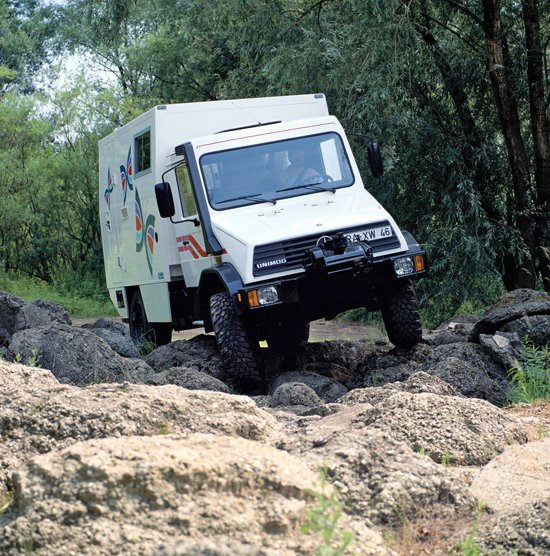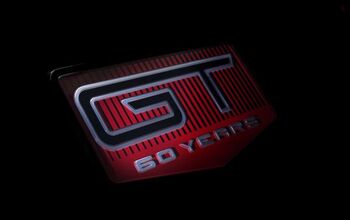Going Where No Car Has Gone Before: A Pictorial History Of The Unimog

My first car was a Mercedes. It wasn’t mine. I was 8 and was not allowed to own a car, let alone drive it. It also wasn’t a car, not in the technical sense. It was a Unimog. This is its story …
The farmer neighbor in our small village outside of Munich where I grew up had one, but he was a little shorthanded. So he put me on the truck, lowered the seat so that I could reach the pedals. My mission was to drive slowly down the meadow while that cart wheel hay rake I had in tow collected the hay into nice rows. The neighbor followed with his Lanz Bulldog and a baler. Farmer’s wife and son (and my schoolmate) loaded the bales. The whole scene took place not long after the Unimog was invented. I’m that old. And to this day, I still get hayfever.
In 1945, the war was barely over, Albert Friedrich, former chief engineer of Daimler-Benz’s aircraft engine research division, drew up plans of a special vehicle for farmers.
The short-lived Morgenthau Plan wanted to convert Germany into an agrarian society, and Friedrich wanted to build the truck for it. Ironically, the Unimog should become the workhorse of German industry – and the new German army.
In 1948, large parts of Germany were in rubble, Friedrich showed his „Universal-Motor-Gerät,“ Unimog for short, at an exhibition of the German Agricultural Association in Frankfurt/Main. It was an ingenious design.
Four equal-sized wheels, all-wheel drive with differential locks, portal axles for operation in extremely difficult terrain, power take-offs front and rear, and a small platform for the transport of loads and equipment. The track width was 1,270 millimeters, precisely the distance between two rows of potatoes. It was a tractor, a truck, you could drive it across the rubble, and you could take it to town.
At the end of the show, Friedrich had 150 orders. Even the (for 1948) rather steep price of 11,230 Marks could not discourage the buyers. Friedrich had a prototype, but no factory. Friedrich’s team selected the Werkzeugmaschinenfabrik Boehringer factory in Göppingen for production.
By the end of 1950, 600 units of the motorized implement had come off the very limited capacity assembly line in Göppingen. The Boehringers could not keep up with the demand. In 1951, Daimler-Benz bought the operation. Their OM 636 diesel engine had already powered the first prototypes. With 25 hp.
The entire Unimog team, led by chief engineer Albert Friedrich, moved 90 miles west to Daimler’s plant in Gaggenau in the scenic Black Forest. Production could finally keep up with sales. In 1951, some 1,000 units were sold. A year later, sales nearly quadrupled to 3,799 units.
The U.S. military had its eyes on the Unimog since 1947 and was highly impressed by the capabilities of a prototype which had been demonstrated to them in Ludwigsburg.
In 1953, a milspec prototype was finished. The special needs of potatoes could be disregarded. The track width increased from the 1,284 millimeters to 1,600 millimeters and a wheelbase extended to 2,670 millimeters. The engine was the 2.2 liter gasoline engine from the 220 sedan.
After the first demonstration the French immediately demanded a prototype. Gaggenau and Daimler-Benz were in the French Zone. In June 1954, two prototypes were delivered. The French army promptly ordered a total of 1,100 vehicles. Daimler didn’t waste any time and supplied the trucks in 1955.
Military forces from countries all over the world showed great interest in the Unimog S. The most substantial interest was shown by Germany. Germany established its own army again in 1956. The German army immediately bought some 36,000 units of the total volume of 64,242 units built that year of the new Unimog S alias Unimog 404.
The German Army was short of tanks. The Kässbohrer company used Unimog S-404 chassis and bodies to build an armored personnel carrier.
With a turret, the APC could be mistaken for a Soviet T-54 Main Battle Tank. German soldiers promptly dubbed the APC “Neckermann Panzer”, in reference to a famous German discount mail-order house.
The Unimog S did not deviate much from the French army specs. 2,700 millimeters long and 2,000 millimeters wide, it was mounted on a chassis with a track width of 1,630 millimeters and a wheelbase length of initially 2,670 millimeters (2,900 millimeters from 1956).
The 82 hp six-cylinder gasoline engine from the Mercedes 220 gave the Unimog S a blitzkrieg-ready top speed of 95 km/h, almost twice as fast as its diesel-engined predecessor. In a nod to the conscript army, where 18 year olds not only learned to shoot, but also how to drive, the Unimog S received an easy-to-shift synchronized transmission, which replaced the fussy constant-mesh transmission.
In 1971, the Unimog received a 2.8 liter six-cylinder M 130 gasoline engine which developed 110 hp and gave the Unimog S a top speed of 100 km/h.
The Unimog 404 had a brilliant military career. It transported men and materiel, it pulled implements and artillery. Unimogs in uniform did duty as mobile weather station, workshop vehicle, ambulance or mobile orderly room. Even airborne troops had their own Unimog which they could parachute in to wreak havoc behind enemy lines.
The SAS even abandoned its classic Land Rover for the Unimog in the Iraq war. Many, many years after its inception, a few Unimogs even found their ways into the American Army.
The military Unimog was available with a standard folding top (that could be stowed away under the seats complete with the side windows). It also could be ordered with an enclosed all-steel cab and a 3,000 millimeter long platform.
This version of the new Unimog was soon discovered by the civilian world. It could go anywhere, and stood its own in the right lane of the Autobahn.
The Unimog S was used in large numbers by fire brigades around the world. The Unimog S is still being used today as forest fire fighting vehicle, equipment carrier, water tender or foam tender. Decommissioned ones are popular with the go anywhere adventure travel crowd.
One of the most unique characteristics of the Unimog, which earned it an unwavering fan base both in the military and civilian field, are its fording and climbing abilities. The common Unimog can go through two and a half feet of water, and up a 100 percent incline.
Special models can ford nearly four feet of water and master a 110 percent incline.
The Unimog’s fabled ground clearance comes courtesy of its “portal axle,” a feature it had even in the 1948 model. The axle is not in the center of the wheel, but higher up. The wheels are driven through sturdy reduction gears.
Some of the most enthusiastic Unimog owners are – railroad companies. Equipped with couplers, Unimogs can move boxcars around railroad tracks. At Japan’s Shinkansen bullet train, the Unimog does shunting duty. In some Asian countries, Unimogs are used as switch engines.
In that capacity, the Unimog even sets records in Le Mans. Here, the Unimog found work as a safety car for the city’s tram system. It can tow whole trams around the yard. Equipped with a hydraulic rerailing system, it can get derailed trains back on track, apart from its daily duties of cleaning grooved tramway rails.
From 1985, Daimler-Benz replaced the entire Unimog range in several steps. A few years later, the top-of-the-range Unimog U 2450 L 6×6 was launched, a three-axle vehicle with a 240 hp engine.
After 1992, the lightweight and medium-duty 408 and 419 series, followed. They found immediate employment in the municipal field, but it also immediately went on vacation. This product range became very popular as a basis vehicle for extremely mobile off-road motorhomes.
The small UX 100, a compact implement carrier, also has high appeal with city fathers.
In 2002, production was moved to the Wörth plant near Karlsruhe. This factory now produces the U 3000, U 4000 and U 5000 series, which debuted in 2002.
In the 90’s, the whole German car industry moved upmarket. Even the Unimog caught the bug. 1994 brought the “Funmog”, just in case that black tie event was off the beaten path. Thankfully, the Funmog was limited to twelve copies. Prices started at DM150,000.
2005 saw the Über-Unimog: Tuned by Brabus, the Unimog Black Edition pandered to real and wannabe sheiks and their demanding off-road tastes.
In 2007, the Unimog came back to its blue-collar roots. Based on product range 405, the U20 serves as a universal high-performance implement carrier.
And city cars? The perfect city car is the Unimog. There is rarely a city in Germany that doesn’t have a whole fleet of them.
All pictures courtesy Daimler AG unless otherwise noted. We thank the Daimler History Department for the friendly support.

Bertel Schmitt comes back to journalism after taking a 35 year break in advertising and marketing. He ran and owned advertising agencies in Duesseldorf, Germany, and New York City. Volkswagen A.G. was Bertel's most important corporate account. Schmitt's advertising and marketing career touched many corners of the industry with a special focus on automotive products and services. Since 2004, he lives in Japan and China with his wife <a href="http://www.tomokoandbertel.com"> Tomoko </a>. Bertel Schmitt is a founding board member of the <a href="http://www.offshoresuperseries.com"> Offshore Super Series </a>, an American offshore powerboat racing organization. He is co-owner of the racing team Typhoon.
More by Bertel Schmitt
Latest Car Reviews
Read moreLatest Product Reviews
Read moreRecent Comments
- ToolGuy If these guys opened a hotel outside Cincinnati I would go there to sleep, and to dream.
- ToolGuy Michelin's price increases mean that my relationship with them as a customer is not sustainable. 🙁
- Kwik_Shift_Pro4X I wonder if Fiat would pull off old world Italian charm full of well intentioned stereotypes.
- Chelsea I actually used to work for this guy
- SaulTigh Saw my first Cybertruck last weekend. Looked like a kit car...not an even panel to be seen.


















































































































Comments
Join the conversation
If you are tired of high beltline cars with gunslit windows you would love a Unimog. If you look at Bertel's last picture of the municipal fleet, the Unimogs in the front row, far left and right you can see how low the front windshield and firewall are. I sat in one a couple of years ago and it seemed like the bottom of the windshield was almost a knee level. Amazing front and side visibility!
I wonder about fuel economy as driving the portal axles. Anything geared eats up energy and the thirst must be considerable. I've always wanted to learn more about the Unimog and now I have! Danke, Herr Schmitt!